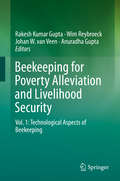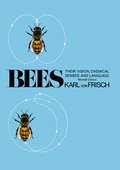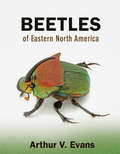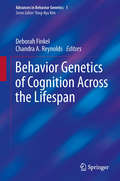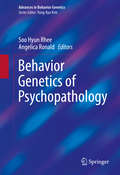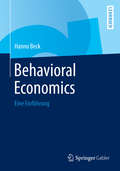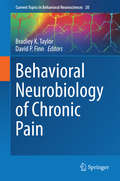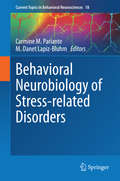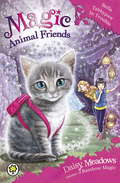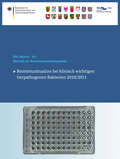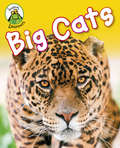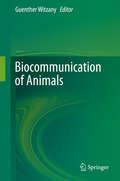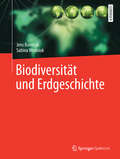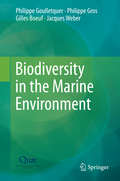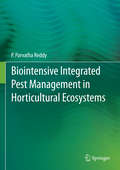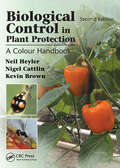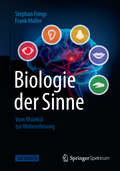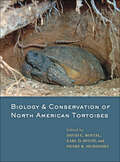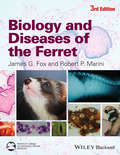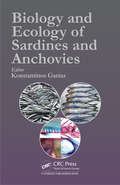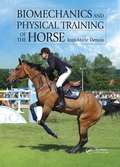- Table View
- List View
Beekeeping for Poverty Alleviation and Livelihood Security: Vol. 1: Technological Aspects of Beekeeping
by Rakesh Kumar Gupta Wim Reybroeck Johan W. Veen Anuradha GuptaThis Book intends to address all aspects needed to develop beekeeping into a powerful instrument of rural development and will focus on beekeeping as a tool for Poverty Alleviation and Livelihood security. In the backdrop of the social and economic issues of the people living in poverty region, the book aims to delineate specific motivation approaches to engage them in beekeeping and will serve as a guide for effective marketing through diversification and value addition of bee products. Nevertheless, marketing and environmental issues will remain an important component of this book. The aim is also to focus on indirect benefit of beekeeping so that it is integrated with farming and nature conservation. Other topics include ensuring the provision of practical techniques in handling and management of bees. It will provide detailed information on good contacts with policymakers and authorities; and channels for attracting finance especially in the third world countries. An interdisciplinary approach is the key feature of the book and it will also focus on few case histories and success stories to encourage the reader to take up beekeeping as a new venture gradually in a phased manner like traditional-transitional and modernised beekeeping. With the publication of this book, we hope to hand out a practical guide that will assist all those who are involved in beekeeping for development. We hope it will stimulate beekeeping as an integrated activity with farming and nature conservation and will serve in many households for poverty alleviation and livelihood security.
Bees: Their Vision, Chemical Senses, and Language
by Karl von FrischOver half a century of brilliant scientific detective work, the Nobel Prize-winning biologist Karl von Frisch learned how the world, looks, smells, and tastes to a bee. More significantly, he discovered their dance language and their ability to use the sun as a compass. Intended to serve as an accessible introduction to one of the most fascinating areas of biology, Bees (first published in 1950 and revised in 1971), reported the startling results of his ingenious and revolutionary experiments with honeybees. In his revisions, von Frisch updated his discussion about the phylogenetic origin of the language of bees and also demonstrated that their color sense is greater than had been thought previously. He also took into consideration the electrophysiological experiments and electromicroscopic observations that have supplied more information on how the bee analyzes polarized light to orient itself and how the olfactory organs on the bee's antennae function. Now back in print after more than two decades, this classic and still-accurate account of the behavior patterns and sensory capacities of the honeybee remains a book "written with a simplicity, directness, and charm which all who know him will recognize as characteristic of its author. Any intelligent reader, without scientific training, can enjoy it."—Yale Review
Beetles of Eastern North America (PDF)
by Arthur V. EvansBeetles of Eastern North America is a landmark book--the most comprehensive full-color guide to the remarkably diverse and beautiful beetles of the United States and Canada east of the Mississippi River. It is the first color-illustrated guide to cover 1,406 species in all 115 families that occur in the region--and the first new in-depth guide to the region in more than forty years. Lavishly illustrated with over 1,500 stunning color images by some of the best insect photographers in North America, the book features an engaging and authoritative text by noted beetle expert Arthur Evans.Extensive introductory sections provide essential information on beetle anatomy, reproduction, development, natural history, behavior, and conservation. Also included are tips on where and when to find beetles; how to photograph, collect, and rear beetles; and how to contribute to research. Each family and species account presents concise and easy-to-understand information on identification, natural history, collecting, and geographic range. Organized by family, the book also includes an illustrated key to the most common beetle families, with 31 drawings that aid identification, and features current information on distribution, biology, and taxonomy not found in other guides.An unmatched guide to the rich variety of eastern North American beetles, this is an essential book for amateur naturalists, nature photographers, insect enthusiasts, students, and professional entomologists and other biologists.Provides the only comprehensive, authoritative, and accessible full-color treatment of the region's beetlesCovers 1,406 species in all 115 families east of the Mississippi RiverFeatures more than 1,500 stunning color images from top photographersPresents concise information on identification, natural history, collecting, and geographic range for each species and familyIncludes an illustrated key to the most common beetle families
Behavior Genetics of Cognition Across the Lifespan (Advances in Behavior Genetics #1)
by Deborah Finkel Chandra A. ReynoldsAlong with psychopathology, cognition has been one of the primary phenotypic focal points of the field of behavior genetics since its inception. Francis Galton’s 1874 examination of eminent families in Britain was among the earliest attempts to investigate whether cognitive achievements run in families. This volume presents current methodologies for understanding cognitive abilities that move beyond the outdated nature vs. nurture paradigm. Recent advances in both collection and statistical modeling of twin data, particularly longitudinal twin data, make this an especially advantageous moment to produce a work that presents a collection of the groundbreaking research on cognitive abilities across the lifespan. This volume presents an overview of the current state of quantitative and molecular genetic investigations into the many facets of cognitive performance and functioning across the lifespan.
Behavior Genetics of Psychopathology (Advances in Behavior Genetics #2)
by Soo Hyun Rhee Angelica RonaldAs a dynamic, interdisciplinary field, behavior genetics and its evolution are being followed closely by scientists across the psychological and medical domains. The discoveries surrounding the human genome and the advancement in molecular genetic technologies have led to studies becoming increasingly sophisticated and yielding yet more conclusive and useful results. This is certainly the case in the area of child and adult psychopathology. Behavior Genetics of Psychopathology summarizes the state of the field, examiningthe role of genes and environment as they affect common neurodevelopmental and psychiatric conditions. Emphasizing key research areas (comorbidities, twin studies, the integration of methods), the book assesses the current literature, offers up-to-date findings, sorts through lingering controversies, and identifies a clear future agenda for the field. Expertly-written chapters focus on issues of both general salience that shape behavior genetics of psychopathology, to specific disorders of major clinical importance, among them: ADHD: the view from quantitative genetic research.Autism spectrum disorders and their complex heterogeneityGenetic influences on anxiety and depression in childhood and adolescence.Evidence for etiologically-defined subgroups within the construct of antisocial behavior.Sleep and psychopathology: the reasons for their co-occurrence. Behavioral genetic approaches to the etiology of comorbidity.Epigenetics of psychopathology. This combination of timeliness and depth of coverage make Behavior Genetics of Psychopathology a frontline resource for behavior geneticists, psychologists, psychiatrists, and neuroscientists, and is perfectly suited to graduate students looking to join these fields.
Behavioral Economics: Eine Einführung
by Hanno BeckSeit den siebziger Jahren haben die Erkenntnisse und Forschungen der Psychologie auch Einzug in die Wirtschaftswissenschaften gehalten – sie sollen das Menschenbild der Ökonomen und ihre Modelle realistischer machen. Dieses Buch beschreibt die wichtigsten Methoden, Konzepte und Erkenntnisse der verhaltenswissenschaftlichen Ökonomik (Behavioral Economics) und weitere dazugehörige Forschungsgebiete wie Glücksforschung, Fairness und Neuroökonomie. Das Lehrbuch stellt die wichtigsten theoretischen und empirischen Befunde und Ideen vor, um sie anschließend einer kritischen Würdigung zu unterziehen. Es ist sowohl für Studierende geeignet als auch für Dozenten und Wissenschaftler, die sich über den aktuellen Forschungsstand der Disziplin informieren wollen.
Behavioral Neurobiology of Chronic Pain (Current Topics in Behavioral Neurosciences #20)
by Bradley K. Taylor David P. FinnPain is the most common reason people seek medical help. The treatment of chronic pain is a major unmet clinical need and its impact on health, well-being, society and the economy is immense. Pain is an integrative, whole-systems (patho)physiological phenomenon and behavioural neuroscience plays a key role in advancing our understanding of pain. This volume brings together a series of authoritative chapters written by leading experts in preclinical and clinical aspects of pain neurobiology. Behavioural approaches to the study of persistent or chronic pain in animal models or humans are at the core of the volume, but the anatomical, physiological, neurochemical and molecular mechanisms that underpin behavioural alterations are also emphasized.
Behavioral Neurobiology of Stress-related Disorders (Current Topics in Behavioral Neurosciences #18)
by Carmine M. Pariante M. Danet Lapiz-BluhmStress is such an over-used word that it is at time difficult to define its core features. When is an environment stressful? What does a stressful environment do to the brain and to the body? What are the biological mechanisms by which a stressor affects us? How does stress contributes to the onset and the progression of mental disorders? How do the effects of stress change over the life-time of an individual? These are just some of the overarching questions addressed by this book, thanks to the contribution of some of the world leading experts on the neurobiology of stress at the pre-clinical and clinical levels. Topics include current advances on the neurobiology of stress on various neurobiological systems such as immune, hypothalamic-pituitary-adrenal (HPA) axis, neurogenesis and neuroplasticity, neurotransmitter (glutamate, noradrenaline, dopamine, serotonin and endocannabinoid), neuropeptides, cognition and emotional processing as well as in utero and early postnatal effects. The clinical chapters deal with the relationship of stress and mental disorders such as depression, posttraumatic stress disorder (PTSD), anxiety disorders, schizophrenia, bipolar disorder, substance abuse and addiction, dementia and age-related cognitive decline as well as resilience to stress. Thus, this book brings together some of the most updated and authoritative views on the effects of stress of brain and behavior.
Bella Tabbypaw in Trouble: Book 4 (Magic Animal Friends #4)
by Daisy MeadowsWelcome to a magical world where animals talk and play - just like you and me!Best friends Jess and Lily love all animals. But when they follow a mysterious golden cat into Friendship Forest - a place where animals live in tiny cottages and sip dandelion tea at the Toadstool Cafe - their summer holidays suddenly become much more magical! Goldie has invited Lily, Jess and kitten Bella Tabbypaw for a sleepover! The girls can't wait to spend a night in Friendship Forest, but brave little Bella decides to go exploring on her own - with the Boggits! Lily and Jess must head into the tunnels underneath the forest to find her, but will Grizelda the witch get there first?
Berichte zur Resistenzmonitoringstudie 2010/2011: Resistenzsituation bei klinisch wichtigen tierpathogenen Bakterien (BVL-Reporte #8.6)
by Bundesamt Für Verbraucherschutz Und Lebe StaffDie Anwendung von antibakteriell wirksamen Substanzen in der Veterinärmedizin erfolgt zum einen aus Gründen des Verbraucherschutzes, zum anderen zur Erhaltung der Tiergesundheit. Gleichzeitig führt jeder Einsatz von Antibiotika zur Selektion von bereits bestehenden Resistenzen, auch wird das Entstehen neuer Resistenzmechanismen begünstigt. Aus diesen Gründen müssen nachhaltig wirksame Managementmaßnahmen ergriffen werden, um den Eintrag von resistenten Bakterien insbesondere durch Lebensmittel liefernde Tiere in die menschliche Nahrungskette möglichst gering zu halten bzw. zu vermeiden. Zur Beurteilung der aktuellen Resistenzsituation und –entwicklung ist die Erhebung valider Empfindlichkeitsdaten für tierpathogene Bakterien erforderlich. Das Bundesamt für Verbraucherschutz und Lebensmittelsicherheit (BVL) erhebt diese Daten im Rahmen des Nationalen Resistenzmonitorings (GERM-Vet) seit 2001. Diese Daten ermöglichen es, koordinierende Maßnahmen zu ergreifen und Entscheidungshilfen zur kalkulierten Therapie zu geben.
Bewusstsein und optimierter Wille
by Helmut PfütznerDas Fehlen freien Willens – so die Sorge der Dualisten - entwürdigt den Menschen. Der Text belegt das Gegenteil: das Fehlen macht den Menschen robust und verlässlich. Dazu entwirft das Buch ein auf schrittweise optimierenden Vorgängen basierendes biophysikalisches Iterations-Modell, das die elementaren Funktionen des Gehirns in konsequenter Weise interpretiert. Aus nüchterner Sicht der Biophysik ist es hohe Konzentration von spezifischen Neuronen, die das höchst physische Phänomen des Bewusstseins entstehen lässt. Voraussetzung dafür ist, dass "Vehemenz" des Denkens aufkommt. Bewusstsein ist kein Produkt der Evolution, sondern ein den Naturgesetzen a priori zugegebener Faktor. Der ist zwar beschreibbar, doch nicht erklärbar – ebenso wenig wie Magnetismus oder Gravitation.An die Stelle von „freiem“ Willen rückt „optimierter“ Wille: Das von Ererbtem und Erworbenem geprägte Ich bestimmt das Handeln und Denken in optimierter Weise, gemeinsam mit Einflüssen der Umwelt.p>
Big Cats: Big Cats (Leapfrog Learners)
by Annabelle LynchRead about the exciting world of big cats , in this new series of non-fiction readers.Leapfrog Learners offer fun facts in accessible text, perfect for building reading confidence.
Binny for Short: Book 1 (Binny)
by Hilary MckayFrom the winner of the Costa Children's Book Award 2018.Binny's life has been difficult since her father died and her dreadful old Aunt Violet disposed of her beloved dog, Max. Her world changed then, to a city flat with not enough space for her Mum, her big sister Clem and her small brother James. Definitely no room for a pet.Then one day Aunt Violet dies, leaving a small cottage in Cornwall to Binny and her family. Binny finds herself in a new world once more, full of sunshine and freedom and Gareth, the enemy-next-door and the ideal companion for dangerous dares. But Max is still lost in the past, and it seems impossible that she'll ever find him again...
Biocommunication of Animals
by Guenther WitzanyEvery coordination within or between animals depends on communication processes. Although the signaling molecules, vocal and tactile signs, gestures and its combinations differ throughout all species according their evolutionary origins and variety of adaptation processes, certain levels of biocommunication can be found in all animal species: (a) Abiotic environmental indices such as temperature, light, water, etc. that affect the local ecosphere of an organism and are sensed, interpreted. (b) Trans-specific communication with non-related organisms.(c) Species-specific communication between same or related species. (d) Intraorganismic communication, i.e., sign-mediated coordination within the body of the organism. This book gives an overview of the manifold levels of animal communication exemplified by a variety of species and thereby broadens the understanding of these organisms.
Biodiversität und Erdgeschichte
by Jens Boenigk Sabina WodniokDieses inspirierende und motivierende Lehrbuch zeichnet fächerübergreifend ein beeindruckendes Gesamtbild der biologischen Vielfalt. Spannende Aspekte der Evolution der Erde und des Lebens werden durch interdisziplinäre Verknüpfung geowissenschaftlicher und biowissenschaftlicher Aspekte aus einer ganz neuen Perspektive anschaulich vermittelt. Der Schwerpunkt liegt hierbei – unter Einbeziehung aktuellster wissenschaftlicher Erkenntnisse – auf dem Verständnis von Konzepten und Mechanismen.Dieses Buch richtet sich an Studierende der Bio- und Geowissenschaften und an alle an der Vielfalt des Lebens interessierten Leser. Das innovative Lehrbuchkonzept regt – gleichzeitig als Lesebuch, Bilderbuch und Lexikon der organismischen Biologie – sowohl Anfänger als auch Fortgeschrittene zu einem visuellen und intuitiven Lernen an. Jede Doppelseite bietet ein in sich geschlossenes, anschaulich bebildertes Kapitel mit themenbezogenem Glossar und weiterführenden Verweisen. Für Dozenten und Lehrer, für Schule und Hochschule bietet dieses Buch ein reichhaltiges Nachschlagewerk und einen umfassenden Fundus an didaktisch durchdachten und lernfreundlich illustrierten Lehrmaterialien.Der Inhalt reicht von der Entstehung der Erde über die geowissenschaftlichen Rahmenbedingungen und die Verknüpfung zwischen biologischer und geologischer Evolution bis zur Entstehung des Menschenvon grundlegenden Mechanismen der Entstehung und Erhaltung der Diversität bis zur globalen Verteilung der heutigen Biodiversitätvon den Anfängen der biologischen Systematik in der griechischen Philosophie und der Bibel über die darwinsche Evolution und die Struktur und Funktion von Arten und Organismen bis zu den modernen Erkenntnissen der Megasystematik und Phylogenie.Mit diesem einzigartigen Konzept verschafft dieses Lehrbuch einen soliden Überblick über die Erdgeschichte und Biodiversität. Die Verknüpfung der verschiedenen Fachdisziplinen fördert das Verständnis übergeordneter Prinzipien und naturwissenschaftlicher Zusammenhänge.
Biodiversity in the Marine Environment
by Philippe Goulletquer Philippe Gros Gilles Boeuf Jacques WeberThe oceans cover over 70% of our planet. They are host to a biodiversity of tremendous wealth. Its preservation is now a global priority featuring in several international conventions and a confirmed objective of European policies and national strategies. Understanding the dynamics and the uses of the marine biodiversity is a genuine scientific challenge. Fourteen international experts have got together and identified five priority research themes to address the problem, based on analysing the state of knowledge.
Biointensive Integrated Pest Management in Horticultural Ecosystems
by P. Parvatha ReddyThrough ‘Green Revolution’ in late 1960s, India achieved self-sufficiency in food production, but still the country has not achieved self-sufficiency in production of horticultural crops. Most of the growth in food production during the green revolution period is attributed to the use of higher levels of fertilizers and pesticides which are continuing to destroy stable traditional ecosystems. The challenge before the crop protection scientist is to increase yields from the existing land without harming the environment and resource base. This can be achieved by adopting eco-friendly Biointensive Integrated Pest Management (BIPM) strategy.BIPM incorporates ecological and economic factors into agricultural system design and decision making, and addresses public concerns about environmental quality and food safety. The benefits of implementing BIPM can include reduced chemical input costs, reduced on-farm and off-farm environmental impacts, and more effective and sustainable pest management. An ecology-based IPM has the potential of decreasing inputs of fuel, machinery, and synthetic chemicals-all of which are energy intensive and increasingly costly in terms of financial and environmental impact. Such reductions will benefit the grower and society.The present book deals with the most recent biointensive integrated approaches for pest management utilizing components such as bioagents [predators, parasitoids and pathogens (bacteria, fungi, viruses)], botanicals (biofumigation, oil cakes, FYM, compost, crop residues, green manuring and other organic amendments), arbuscular mycorrhizal fungi, physical methods (hot water treatment of planting material, soil solarization), cultural methods (crop rotation, summer ploughing, fallowing, intercropping, pruning, mulching, spacing, planting date, trap cropping, etc.), biorational chemicals (pheromones) and resistant cultivars. This book can serve as a useful reference to policy makers, research and extension workers, practicing farmers and students. The material can also be used for teaching post-graduate courses.
Biological Control in Plant Protection: A Colour Handbook, Second Edition
by Neil Helyer Nigel D. Cattlin Kevin C. BrownThere has been a large increase in the commercial use of integrated crop/pest management methods for pest and disease control on a wide range of crops throughout the world since the first edition of this book. The completely revised second edition of the bestselling Biological Control in Plant Protection: A Color Handbook continues the objective of
Biologie der Sinne: Vom Molekül zur Wahrnehmung
by Stephan Frings Frank MüllerUnsere Sinne - Sehen, Hören, Riechen, Schmecken und Tasten - bestimmen wesentlich unser Leben. Alles was wir wissen, wurde uns von unseren Sinnen vermittelt. Aber wie funktionieren unsere Sinne und wie kommt das Wissen über die Welt in unseren Kopf? Nach welchen Kriterien entscheidet unser Gehirn, was zu tun ist?In diesem Sachbuch wird allgemeinverständlich dargelegt, wie hoch entwickelt die Sinnesorgane bei Tieren und Menschen sind. Oft erreichen Sinnesleistungen die Grenze des physikalisch Möglichen. Das Buch erklärt, wie Sinnesreize erfasst werden, wie sie in die Sprache des Nervensystems übersetzt werden und wie unser Gehirn Sinnesinformation verarbeitet. Das Gehirn setzt dabei auf wohl bewährte Strategien, die ein Ziel verfolgen: die Überlebenschance des Organismus zu erhöhen. Deshalb wird in diesem Buch gezeigt, wie sehr die Sinnesleistungen durch die Evolution geformt und bestimmt wurden. Das Buch zeigt auch, dass viele Tiere ihre Umwelt vollkommen anders wahrnehmen als wir.
Biology and Conservation of North American Tortoises
by David C. Rostal Earl D. McCoy Henry R. MushinskyTortoises, those unmistakable turtles, evolved from a lineage that split off from the familiar pond turtles roughly 100 million years ago. Over time, these plant-eating land turtles spread around the world, growing to an enormous size (depending on the species) and living so long that they have become the stuff of legends. By most accounts, they are indeed the longest-lived of the turtles, with good records suggesting individuals may live as long as 180 years (anecdotal records suggest that some reach ages of 200 years or more).Providing the first comprehensive treatment of North America’s tortoises, Biology and Conservation of North American Tortoises brings together leading experts to give an overview of tortoise morphology, taxonomy, systematics, paleontology, physiology, ecology, behavior, reproduction, diet, growth, health, and conservation. The contributors carefully combine their own expertise and observations with results from studies conducted by hundreds of other researchers. The result is a book that belongs in the library of every herpetologist.ContributorsGustavo Aguirre L.Linda J. AllisonMatthew J. ArescoRoy C. Averill-MurrayJoan E. BerishKristin H. BerryDennis M. BrambleK. Kristina DrakeTaylor EdwardsTodd C. EsqueRichard FranzCraig GuyerJ. Scott HarrisonSharon M. HermannJ. Howard HutchisonElliott R. JacobsonValerie M. JohnsonRichard T. KazmaierEarl D. McCoyPhilip A. MedicaRobert W. MurphyHenry R. Mushinsky Kenneth E. NussearMichael P. O’ConnorThomas A. Radzio David C. RostalLora L. SmithJames R. SpotilaCraig B. StanfordC. Richard TracyTracey D. TubervilleMichael TumaThane Wibbels
Biology and Conservation of North American Tortoises
by David C. Rostal Earl D. McCoy Henry R. MushinskyTortoises, those unmistakable turtles, evolved from a lineage that split off from the familiar pond turtles roughly 100 million years ago. Over time, these plant-eating land turtles spread around the world, growing to an enormous size (depending on the species) and living so long that they have become the stuff of legends. By most accounts, they are indeed the longest-lived of the turtles, with good records suggesting individuals may live as long as 180 years (anecdotal records suggest that some reach ages of 200 years or more).Providing the first comprehensive treatment of North America’s tortoises, Biology and Conservation of North American Tortoises brings together leading experts to give an overview of tortoise morphology, taxonomy, systematics, paleontology, physiology, ecology, behavior, reproduction, diet, growth, health, and conservation. The contributors carefully combine their own expertise and observations with results from studies conducted by hundreds of other researchers. The result is a book that belongs in the library of every herpetologist.ContributorsGustavo Aguirre L.Linda J. AllisonMatthew J. ArescoRoy C. Averill-MurrayJoan E. BerishKristin H. BerryDennis M. BrambleK. Kristina DrakeTaylor EdwardsTodd C. EsqueRichard FranzCraig GuyerJ. Scott HarrisonSharon M. HermannJ. Howard HutchisonElliott R. JacobsonValerie M. JohnsonRichard T. KazmaierEarl D. McCoyPhilip A. MedicaRobert W. MurphyHenry R. Mushinsky Kenneth E. NussearMichael P. O’ConnorThomas A. Radzio David C. RostalLora L. SmithJames R. SpotilaCraig B. StanfordC. Richard TracyTracey D. TubervilleMichael TumaThane Wibbels
Biology and Diseases of the Ferret
by James G. Fox Robert P. MariniBiology and Diseases of the Ferret, Third Edition has been thoroughly revised and updated to provide a current, comprehensive reference on the ferret. Encyclopedic in scope, it is the only book to focus on the characteristics that make the ferret an important research animal, with detailed information on conditions, procedures, and treatments. Offering basic information on biology, husbandry, clinical medicine, and surgery, as well as unique information on the use of ferrets in biomedical research, Biology and Diseases of the Ferret is an essential resource for investigators using ferrets in the laboratory and for companion animal and comparative medicine veterinarians. The Third Edition adds ten completely new chapters, covering regulatory considerations, black-footed ferret recovery, diseases of the cardiovascular system, viral respiratory disease research, morbillivirus research, genetic engineering, hearing and auditory function, vision and neuroplasticity research, nausea and vomiting research, and lung carcinogenesis research. Additionally, the anesthesia, surgery, and biomethodology chapter has been subdivided into three and thoroughly expanded. The book also highlights the ferret genome project, along with the emerging technology of genetically engineered ferrets, which is of particular importance to the future of the ferret as an animal model in research and will allow the investigation of diseases and their genetic basis in a small, easily maintained, non-rodent species.
Biology and Diseases of the Ferret
by James G. Fox Robert P. MariniBiology and Diseases of the Ferret, Third Edition has been thoroughly revised and updated to provide a current, comprehensive reference on the ferret. Encyclopedic in scope, it is the only book to focus on the characteristics that make the ferret an important research animal, with detailed information on conditions, procedures, and treatments. Offering basic information on biology, husbandry, clinical medicine, and surgery, as well as unique information on the use of ferrets in biomedical research, Biology and Diseases of the Ferret is an essential resource for investigators using ferrets in the laboratory and for companion animal and comparative medicine veterinarians. The Third Edition adds ten completely new chapters, covering regulatory considerations, black-footed ferret recovery, diseases of the cardiovascular system, viral respiratory disease research, morbillivirus research, genetic engineering, hearing and auditory function, vision and neuroplasticity research, nausea and vomiting research, and lung carcinogenesis research. Additionally, the anesthesia, surgery, and biomethodology chapter has been subdivided into three and thoroughly expanded. The book also highlights the ferret genome project, along with the emerging technology of genetically engineered ferrets, which is of particular importance to the future of the ferret as an animal model in research and will allow the investigation of diseases and their genetic basis in a small, easily maintained, non-rodent species.
Biology and Ecology of Sardines and Anchovies
by Konstantinos GaniasApart from being commercially and socially significant, anchovies and sardines populations occupy crucial positions in the oceans' ecosystems. Low in the food chain, clupeoids tend towards abundance, as if their purpose in life was to be eaten and fuel the upper levels of marine trophic chains. The present book covers a broad spectrum of topics on
Biomechanics and Physical Training of the Horse
by Jean-Marie DenoixEffective horse trainers strive to improve the performance of their horses while preserving the integrity of the musculoskeletal apparatus. Biomechanics and Physical Training of the Horse supplies an anatomical and functional overview of the topic, enabling trainers to optimize the different exercises their horses undergo during training and compet
